Succulents are an amazingly diverse category of plants. The word “succulent” doesn’t refer to a particular family of plants; it refers to a wide variety of different families of plants that evolved to have fleshy leaves that store a lot of water, to help them survive droughts and other harsh environmental conditions.
That adaptation also makes many species of succulents great houseplants. They are resilient, low maintenance, and unique looking.
Here are 12 of our favorite indoor succulents.
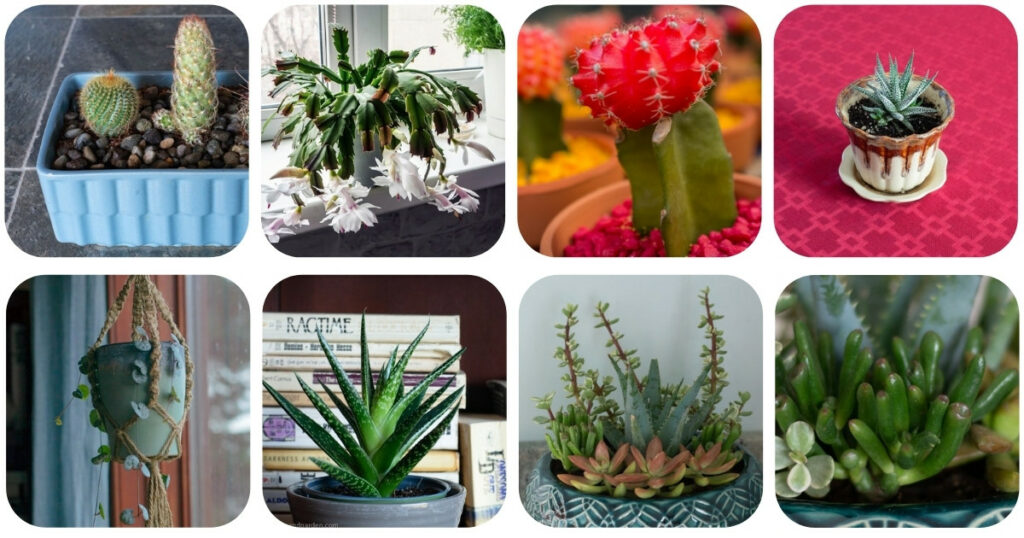
What Makes A Succulent Suitable For Growing Indoors?
Any succulent can be grown indoors if you provide a suitable growing environment, but certain succulents really thrive inside your home.
Our favorite succulents to grow indoors have two things going for them. They have unique visual appeal and are particularly tolerant of the constraints of an indoor growing environment.
Visual Appeal
Of course, visual appeal is in the eye of the beholder. While taste varies, the truth is there are certain houseplants so common and boring that you hardly notice them, and then there are succulents like moon cactus and lithops that look like they’re from another planet!
We all have limited windowsill space, especially south-facing, and limited time to tend to houseplants. That means we’ve omitted any ordinary-looking succulents. Our philosophy is that a plant should be a potential conversation starter and bring you joy to look at, so our favorite indoor succulents are all particularly eye-catching.
The succulents that earned a place on our list all have one or more of the following specific types of visual appeal:
- Leaves that are distinctive in color, often with variegation or color variation along the edge of the leaf
- Leaves that are unusual shapes or have spiky edges or other accessories
- Growing habits that are distinctive, such as a trailing habit, a tendency to create lots of offsets, or the capacity to be grown as a bonsai
- Flowers
Well Suited to An Indoor Growing Environment
Our favorite indoor succulents all make happy, healthy houseplants either because they evolved to thrive in a similar environment or are very resilient to being grown outside their preferred environment.
While no plant is perfect, each of the succulents on our list has several of the following indoor-friendly characteristics:
- Prefers or can tolerate low light, a non-south-facing window, or even indirect sunlight exclusively
- Slow growing, so you don’t have to repot frequently
- Small maximum size, so it won’t take up a lot of windowsill space
- Doesn’t need a dormancy period (i.e., can tolerate living in a consistently climate-controlled environment year-round)
- Tolerant of infrequent or irregular watering
- Resistant to disease and pests
- Pet-safe
While there are many other succulents we could have listed, not all succulents are well suited to an indoor environment. For example, bears paw don’t just thrive in full sun; they need it. In a north-facing window, they will grow leggy and weak-stemmed. Similarly, many cacti also prefer a hotter, sunnier environment than most households can provide.
The good news is that many attractive and low-maintenance options will thrive in any household.
Twelve of the Best Succulents To Grow Indoors
Zebra Haworthia

Also Known As: Zebra plant
Family: Cactaceae family
Botanical Name: Haworthiopsis fasciata and Haworthiopsis attenuata
There’s no mystery where these plants got their name. The common name “zebra haworthia” is a category that includes two species of aloe-shaped plant with long green leaves decorated with white dots that sometimes form stripes. The two varieties have similar care needs.
These are great houseplants for any household because they do not require direct sunlight. Even low indirect light is fine. Excessive sun exposure can turn the leaves paler green, which reduces the visually appealing contrast between the green and the white.
- Provide good drainage and avoid overwatering.
- Indoors this plant is likely to skip its summer and winter dormancy, which is fine.
- If the tips of the leaves get brown, don’t worry, this is a normal part of the plant’s life cycle. Just pinch off the dead bits.
- Zebra haworthia tends to have longer roots than most succulents, so don’t plant yours in a short pot like you would many succulents. Stick with a pot that has standard proportions.
- Zebra haworthia can be sensitive to transplant shock unless they are well-hydrated. When you are going to repot the plant, make sure to water it a couple of days in advance.
- Zebra haworthia is pet-safe.
Variegated String of Hearts
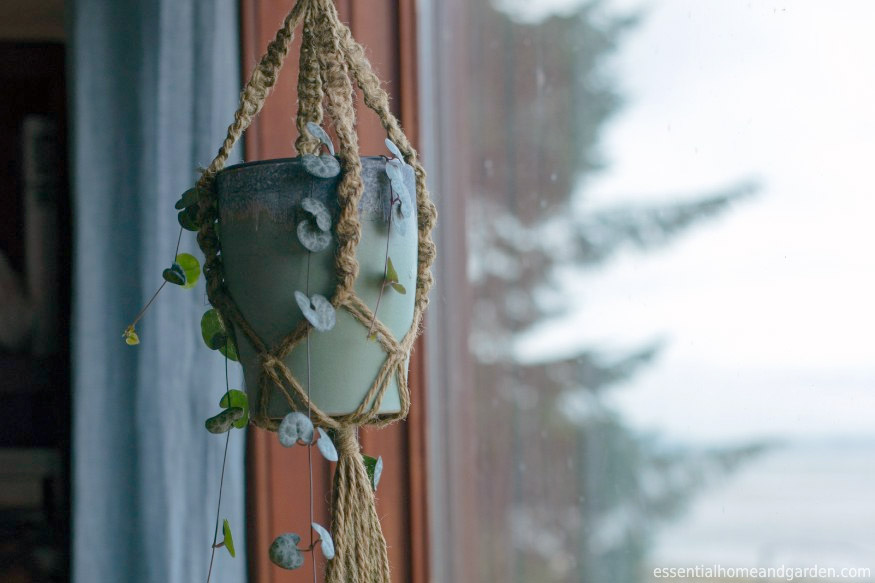
Family: Apocynaceae family
Botanical Name: Ceropegia woodii
If you are looking for a beautiful hanging plant for a north- or east-facing window, look no further than a string of hearts.
This plant is a winner in every category: undemanding of direct sunlight and water, beautiful foliage and growing habit, cute flamingo-look-alike flowers, and interesting-looking aerial tubers that resemble garbanzo beans and make propagating the plant a snap.
This plant’s mottled silver and green leaves are scattered along delicate, purple, trailing stems. While most succulents are slow-growers, my string of hearts’ stems has grown to more than two feet long in the six months since I propagated them from tubers in a pot hanging in a north-facing window.
- Likes a lot of light but not intense direct light, which can cause sunburn. A bright non-south-facing window is perfect, and bright indirect light will likely work.
- If the leaf placement gets stretched out or the leaf variegation fades, move it to a brighter location.
- Provide good drainage and avoid overwatering.
- Winter-dormant.
- Easily propagated. You can use the tubers to grow new plants or add them to your existing plant to bulk it up faster.
- The variegated string of hearts is pet-safe. It was traditionally consumed as medicine and emergency famine food in South Africa. It has a mildly tart flavor like lettuce and rhubarb had a baby, but we recommend appreciating your string of hearts with your eyes rather than your mouth.
Aloe Vera
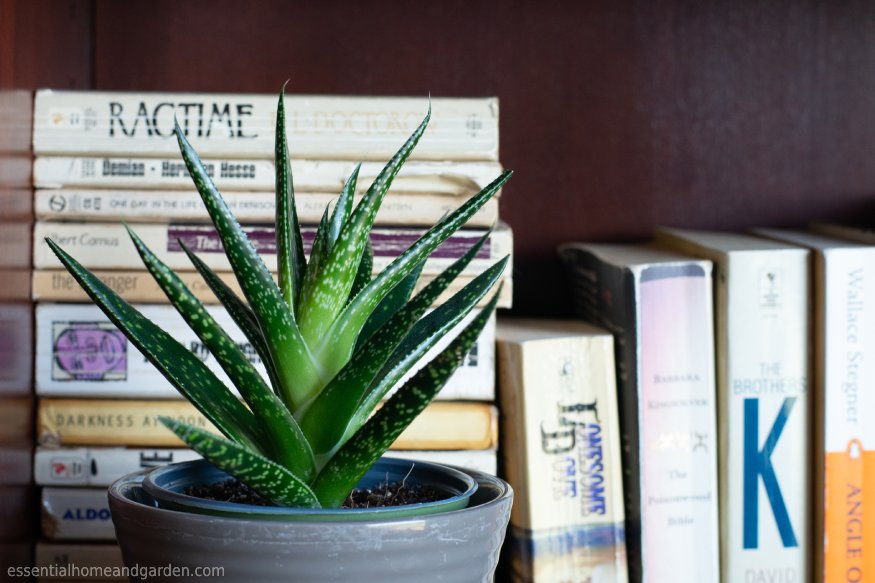
Family: Asphodelaceae family
Botanical Name: Aloe vera
Aloe vera is a valued ingredient in cosmetics and cleansers. It can also be applied topically (on the skin) for burn treatment. But honestly, who wants to cut up such a slow-growing houseplant? The long pointed leaves are dramatic, as foliage goes.
While it looks like a plant you might find in the open desert, aloe vera grows quite well indoors. A south-facing window is preferable, but they do fine in east- or west-facing windows.
To be honest, mine is growing in a bright north-facing window. It would probably be a bit more compact if it got more light, but it is still a healthy and attractive plant.
Some consider aloe one of the most idiot-proof of all houseplants, so it makes a great starter plant or gift.
- Aloe vera will only flower if given plenty of direct light, but if you are willing to forego flowers, it is tolerant of lower-light conditions.
- Protect your aloe vera from drafts and cold windows in the winter to avoid discoloration or damage to the leaf tips.
- Propagate using offsets. I am experimenting with propagating leaves, and after nine months, the leaves are still healthy but have grown roots less than an inch long with no above-soil growth.
- Provide good drainage and avoid overwatering, especially in a cooler household. Aloe thrives in the desert, so they do not like wet roots.
- Aloe vera is not safe for consumption by humans or pets.
Living Stones

Family: Aizoaceae family
Botanical Name: Lithops
If you love houseplants, especially if you live in an apartment, you will inevitably face the universal problem: running out of space in your south-facing windows. One solution is to pick shade-tolerant houseplants, but another option is to opt for tiny houseplants.
Lithops is the perfect succulent if you only have a little space because these cute-as-a-button plants only grow an inch tall and a couple of inches wide. They are so adorably tiny they bat way outside their league when it comes to attracting attention.
You can grow a pot of just lithops or stick them in with other plants as a low-height element in your arrangement.
- Prefers full sun, but they’re okay with five hours per day, so an east- or west-facing window may work.
- These are desert plants, so at all costs, avoid overwatering.
- They may have one or more dormant periods each year, during which time it’s especially important not to water them, even for months at a time.
- Because Lithops are so short and shallow-rooted, they are well suited to various unusual planter options.
- Lithops are pet-safe.
String of Dolphins
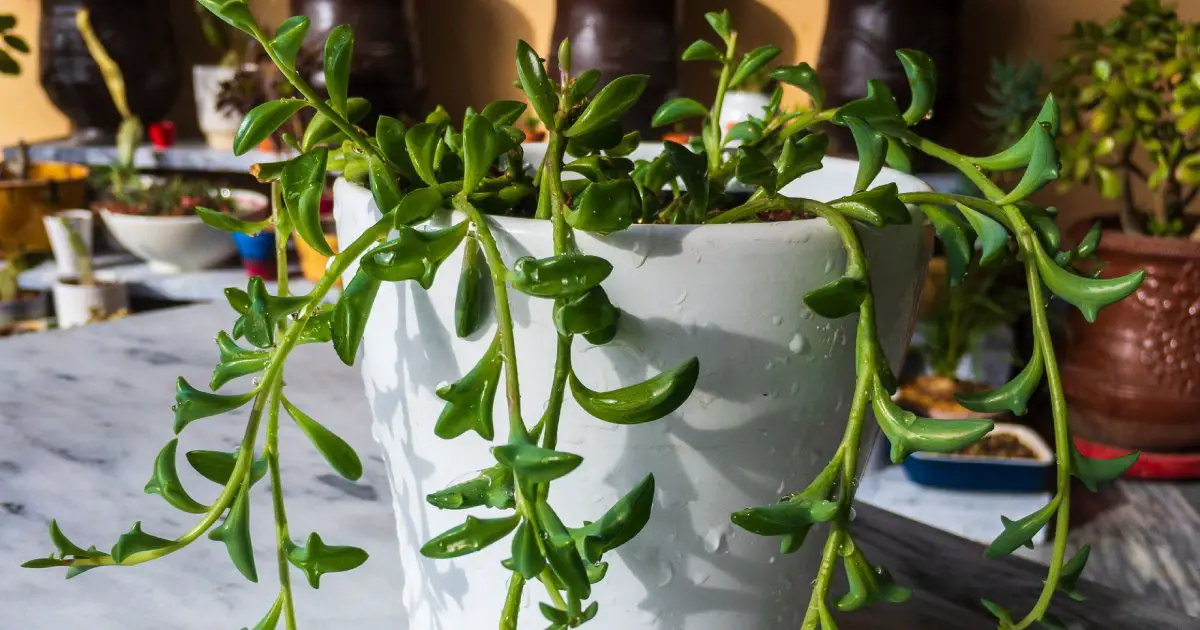
Family: Asteraceae family
Botanical Name: Senecio peregrinus
Nobody can deny this is one of the most interesting succulents available when it comes to foliage. It is known not for its flowers but for its long stems with a trailing habit and leaves shaped like dolphins.
While normally a pretty light green, extra sunlight can give it a light reddish pigmentation (and too much can cause sunburn). If you’re content with green, it’s a succulent that doesn’t mind an east- or north-facing window. It’s a great indoor plant for either a hanging or a standard pot.
It can be slightly more finicky than some other succulents, but to be fair, it’s not saying much for a plant to need more attention than a cactus does.
- Bright indirect light is ideal. It does not like the direct summer afternoon sun. If it gets leggy, move it to an area with brighter or more light.
- Indoors this plant tends not to go dormant in the winter. It is more likely to grow slowly year-round.
- Likes more frequent watering than most succulents. Use an appropriate watering method, but do it a little more frequently than you would for other succulents. Only let the top inch or two of the soil dry out before you water again.
- If the leaves begin to shrink or shrivel, your plant is probably dehydrated.
- When you water, try to avoid getting water on the foliage. If the plant’s crown grows dense, trapped water can cause rot.
- Poisonous to humans and pets.
For more tips, check out our String of Dolphins growing guide.
Elephant Bush
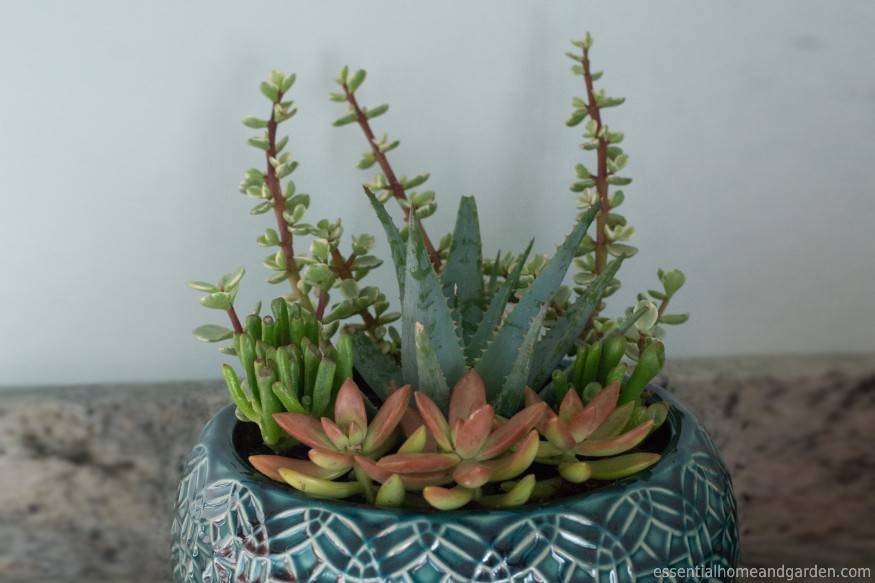
Also Known As: Money tree, Lucky plant
Family: Didiereaceae family
Botanical Name: Portulacaria afra
Don’t let its name mislead you. Although outdoors elephant bush can grow as large as 20 feet, what makes the elephant bush a particularly fun succulent to grow indoors is that you can grow it in miniature as a bonsai tree.
Another fun fact that makes this succulent unique is that it is not only non-toxic, but it is also actually edible! If some unexpected dinner guests show up and you’re a little short on lettuce for your salad, just throw in some elephant bush leaves. They are tasty and high in Vitamin C.
They’re called elephant bush, not because of their size but because elephants love to eat them (and some say the leaves are shaped like elephant ears). There is a variegated variety with attractive yellow and green leaves, as well as the typical variety, which is the color of a jade plant.
- Start by offering it as much indoor sun as possible. If you see evidence of sunburn, move it somewhere so that it won’t get direct afternoon sun.
- If your elephant bush’s stems get too long, it will become top-heavy and fall over. Either prune your elephant bush to keep it small or provide some support when needed.
- A large, mature elephant bush will develop corking (hard woody growth) beginning at the base of the stem. This is a natural part of the plant’s growth cycle. It provides additional support to prevent top-heavy branches from snapping under the weight of the leaves.
- Use a pot with good drainage. Consider using a bonsai-specific pot.
- Avoid overwatering to avoid root rot and other problems.
- Elephant bush is totally pet-safe.
Gollum Jade
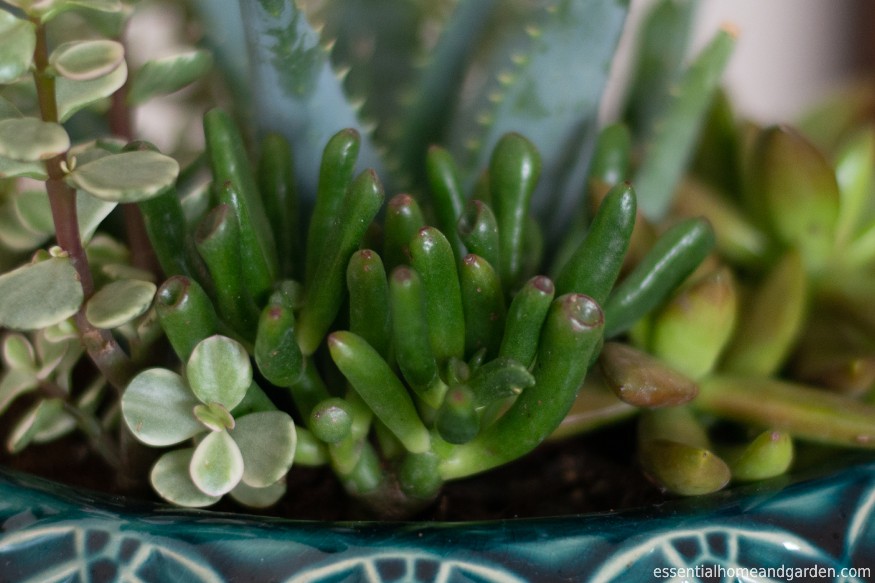
Also Known As: Finger jade, ET’s fingers, Hobbit’s pipe, Trumpet jade
Family: Crassulaceae family
Botanical Name: Crassula ovata ‘Gollum’
Most kinds of jade are attractive but not all that interesting to look at, and they tend to need a lot of direct sunlight to avoid getting leggy. Not so with Gollum jade, a hybrid that thrives in bright indirect light and looks, like its namesake, both endearing and weird.
Instead of typical jade leaves, this plant’s leaves are long, oblong, clustered together, and growing in the same direction, so the nickname ET’s hand is really on the mark. The leaves are an attractive green, often with pink at the tip (ET’s nail polish, presumably).
The young plant rests on the soil like a stonecrop, but the mature plant grows like a tree with a woody trunk.
- The ideal location is an east-facing window to give this plant a few hours of direct morning sunlight but protect it from harsher afternoon rays.
- Provide good drainage and avoid overwatering.
- They don’t mind humidity; you can grow them in a well-lit bathroom.
- Mature gollum jade will develop corking, which is hard woody growth starting at the base of the stem. This is a natural part of the plant’s growth to stop the heavy foliage from breaking off from the plant. It is nothing to worry about.
- If a piece does snap off, propagate it.
- Gollum jade is not pet-safe.
Snake Plant
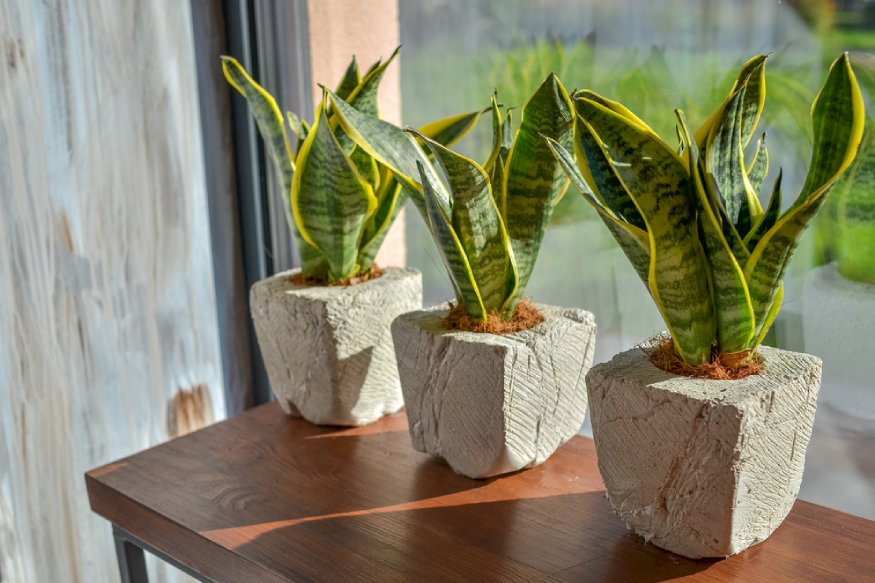
Also Known As: Mother-in-law’s tongue, Saint George’s Sword
Family: Asparagaceae family
Botanical Name: Sansevieria trifasciata
Snake plant is an unusual succulent in the same family as asparagus and agave. There are several cultivars with various colors, but generally, the leaves are large, long, and multi-colored, with stripes running along the edges. They are also not fleshy like most succulents.
It will tolerate all sorts of poor conditions, neglect, and other abuse, making it a great choice as a beginning houseplant or an office plant.
One of the best reasons to grow a snake plant indoors is that you should not grow it outdoors (in the ground). It sends out underground runners and can spread invasively like bamboo, so keep it in a pot.
- Snake plants can grow in anything from full sun to shade, although they can be sunburned. They grow well indoors, even in indirect light, but their growth rate will be a bit slower.
- When you repot, be careful not to replant them too deep.
- Water like a conventional succulent (letting the soil dry out thoroughly before watering again).
- Will tolerate a wide variety of soil types, although (like all succulents) it prefers a pot and potting mix that provide good drainage.
- This plant is resistant to nearly all pests and diseases.
- Snake plants are toxic, so don’t grow them if you have pets or small children.
Burro’s Tail
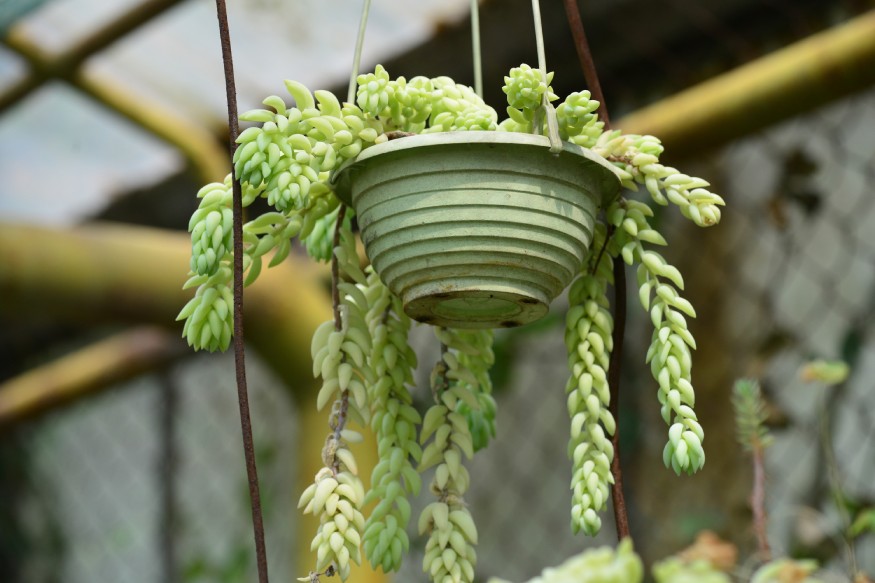
Also Known As: Donkey tail, Burrito sedum
Family: Crassulaceae family
Botanical Name: Sedum Morganianum
Burro’s tail is an unusual-looking succulent, It has a compact arrangement of leaves on trailing stems of up to a couple of feet long, and its branches resemble heavy braids. The jade green to gray, bluish leaves are fleshy and waxy. In the summer, the end of each branch develops a cluster of flowers that are most commonly pink but can come in other colors.
- This succulent likes a lot of light but will tolerate partial shade in an east- or west-facing window. If it begins to stretch, move it to a sunnier spot or add a sunlamp.
- Be gentle when repotting or moving the plant; the branches are prone to breaking.
- If a piece of stem does break off, you can propagate the leaves.
- Avoid overwatering.
- This plant is too fragile to move around every time you water it, so don’t use the pot in a pot method.
- Burro’s tail is non-toxic and pet safe.
Silver Ball Cactus

Family: Cactaceae family
Botanical Name: Parodia scopa
You might assume that even if some succulents thrive in low light, cacti are desert plants that all need full sun, but that isn’t true. Our last three recommendations are all cacti.
Parodia cacti are small circular green cacti with spines and a thorny crown. They can produce flowers in the summer. Unfortunately, due to land clearing for livestock grazing, the silver ball cactus is considered an IUCN Red List threatened species in the wild. So make sure to purchase your plants from a responsible grower who propagates them, not a seller who harvests wild specimens.
- Silver ball cactus prefers indirect sunlight.
- Provide well-draining potting soil, and plant in a pot with a drainage hole to avoid wet, rotting roots.
- It is quite drought-resistant. Do not overwater.
- Although it is non-toxic, it is best to avoid keeping your silver ball cacti where kids and pets can access it (but to be honest, your small child or pet would have to be pretty weird to try to snack on such a spiny plant).
Holiday Cactus
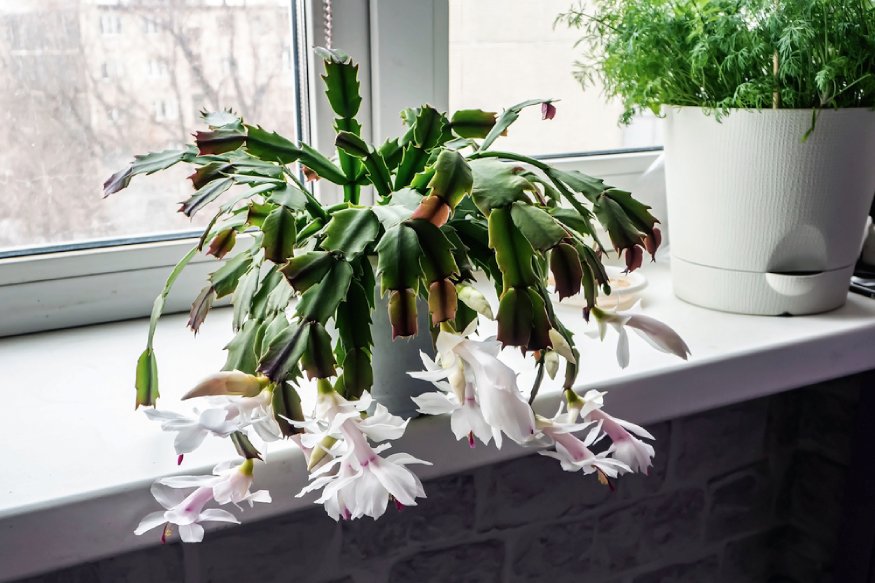
Family: Cactaceae family
Botanical Name: Schlumbergera truncata(Thanksgiving Cactus),
Schlumbergera bridgesii (Christmas Cactus),
Rhipsalidopsis gaertneri (Easter/Spring Cactus)
There’s a good reason holiday cacti are one of the most common houseplants. They grow well, can live an extremely long time, and produce abundant colorful flowers in the fall, winter, or spring, depending on the species.
The three types of holiday cactus look very similar, but there is some variation in their leaf shape and flower color. There’s a reason most people forget these plants are cacti; they are very unusual for cacti. They are not desert plants but grow up in trees in jungles, which means they can tolerate shade and higher humidity than most cacti.
- While they tolerate direct sunlight, they do wonderfully without it, so they’re a great choice for non-south-facing windows.
- Unlike most succulents, holiday cacti appreciate humidity, so they’re a good choice for a bright bathroom.
- You may need to force a dormancy period by limiting light exposure to 9-12 hours a day at most to get your holiday cacti to flower.
- Because they put on such a good show, holiday cacti enjoy a bit more fertilizer than typical succulents.
- Your holiday cactus may develop corking, which is hard woody growth starting at the base of the stem. This is a natural part of the plant’s growth cycle. It provides support so the heavily laden branches won’t snap under the weight of the leaves and flowers or pull right out of the soil.
- Provide good drainage, and avoid overwatering.
- Holiday cacti are pet-safe, which is important due to the flowers inevitably falling off.
Moon Cactus

Family: Cactaceae family
Botanical Name: Gymnocalycium mihanovichii
We’ve saved the best and weirdest for last. If you’re a succulent pro looking to spice up your collection, the moon cactus is a great choice.
These are mutant hybrid cultivars that can’t live on their own, so they are grafted on top of another cactus. If you ever wondered what a cactus would look like wearing a colorful cauliflower for a hat, the answer is a moon cactus.
They can’t handle direct sunlight, so they’re the ultimate indoor succulent. But even if you take great care of it, a moon cactus will likely only live a few years, so enjoy it, but don’t get too attached.
- Moon cactus cannot tolerate direct sunlight. Keep it in bright indirect light.
- Drought tolerant. Avoid poor drainage or overwatering.
- Moon cactus is nontoxic but spiny, so keep it away from pets and small children.
A Dazzling Dozen Succulents to Grow Indoors
No matter what niche you are looking to fill, there is a succulent that will be perfect for the opening. Whether it’s a steamy south-facing bathroom windowsill or a dim office building, there is a succulent that will grow happy and healthy there. The best part is that you don’t have to compromise on appearance because each one of these plants has a great visual impact and will bring new life to your room.

